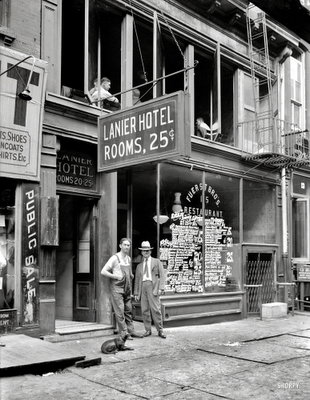The opening of Alan Durning’s Slate piece in praise of the so-called flophouse, the cheap and tiny living quarters which used to be a staple of every major American metropolis, and are, perhaps, making a comeback:
“Most Americans live in houses or apartments that they own or rent. But a century ago, other less expensive choices were just as common: renting space in families’ homes, for example, or living in residential hotels, which once ranged from live-in palace hotels for the business elite to bunkhouses for day laborers. Working-class rooming houses, with small private bedrooms and shared bathrooms down the hall, were particularly numerous, forming the foundation of affordable housing in North American cities. Misguided laws and regulations almost wiped out these other kinds of housing, with disastrous consequences, but now there’s a chance for them to come back, helping those who are young, single, or on the lower rungs of our increasingly unequal society.
In the early decades of the 20th century, rooming houses offered affordable housing for America’s urban working class. Some offered boarding, with a kitchen and dining hall in the basement. In San Francisco a century ago, a passable room might cost 35 cents a night ($8 in today’s currency). Concentrated near downtowns, rooming houses and other forms of residential hotels provided quintessentially urban living. The dense mixture of accommodations with affordable eateries, laundries, billiard halls, saloons, and other retail establishments made life convenient on foot and on slim budgets.
The past century of rising affluence started the decline of the rooming house. With higher incomes, we bought more space and privacy. Young, upwardly mobile, enterprising residents moved out of hotels, depriving hotel districts of their best customers. Those left behind were harder to employ, poorer, on the wrong side of the law, or simply eccentric. This trend accelerated in the 1960s and 1970s, when authorities deinstitutionalized many people with mental illnesses and began sheltering them in rooming houses and other cheap hotels. In most cases, mental health authorities intended such arrangements to be temporary. Some planned to build and support constellations of small, neighborhood-based care facilities, for example, but not-in-my-backyard politics intervened. The care facilities never got built, and some of society’s most vulnerable were stranded in rooming houses, which by then had come to be known as single-room occupancy hotels (SROs).
Meanwhile, new state and local laws made residential hotels more expensive to operate. Other rules simply made them illegal outside of historic downtowns. As cities expanded outward, rooming houses could not spread to the new neighborhoods.
The rules were not accidents.” (Thanks Browser.)

